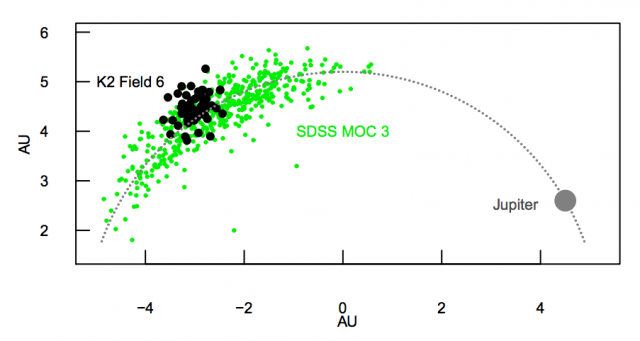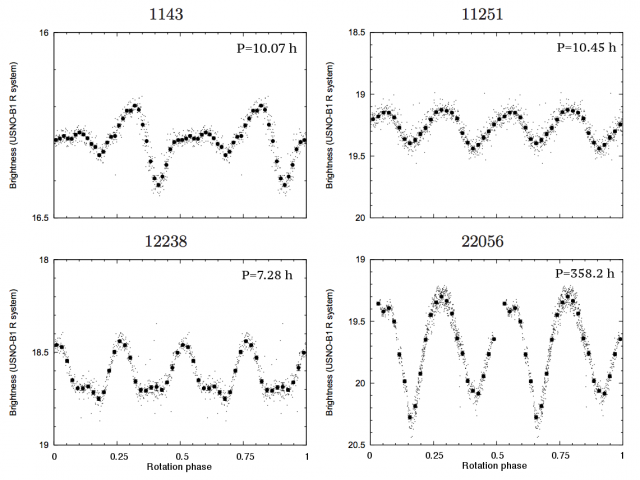Kepler has caught hundreds of asteroids
The Kepler space telescope has been hunting for exoplanets along the ecliptic plane, and it has brought our Solar System into its view as well.
At the beginning, the Kepler space telescope looked straight out from the Solar System, at a direction almost perpendicular to the ecliptic and the plane of the planets. As it was, it could observe the same spot all year long, as the Sun, along with most of the objects in the Solar System, were always to its side. In contrast, in the K2 mission it is observing parallel to that plane in order to better balance against the radiation pressure of the Sun. This new strategy has two important consequences: one is that Kepler has to change its field of view every three months to avoid the Sun; the other is that our own Solar System, unexpectedly, has become a target for the exoplanet-hunting telescope.
A nuisance for some, an opportunity for others
For most astronomers working with Kepler, planets and asteroids zipping through the images represent just one more nuisance they have to look out for when studying the light variations of stars. Researchers from the Konkoly and Gothard Observatories in Hungary, however, saw an opportunity in these moving specks of light. Following up on their work with trans-Neptunian objects, they examined the light variations of some main-belt and Trojan asteroids in two new papers. They used a custom-built pipeline based on the software fitsh, developed by team member András Pál to accurately measure moving targets in the observations of Kepler.
Main-belt asteroids were not targeted by Kepler, so the astronomers selected two extended mosaics that covered the open cluster M35 and the path of the planet Neptune, and simply tracked all known asteroids crossing them. Most of the objects were continuously observable for 1-4 days, which may not sound like much, but is significantly longer than single-night runs achievable with ground-based telescopes. Indeed, the researchers hoped that, with Kepler, they could determine the rotation periods of the asteroids more accurately, without the uncertainties caused by day-time gaps in the data – and they did, but only for a fraction of the sample.
‘We measured the paths of all known asteroids, but most of them turned out to be simply too faint for Kepler. The dense stellar background towards M35 further reduced the number of successful detections’, Róbert Szabó (Konkoly Observatory, MTA CSFK), lead author of the paper, explained. ’Still, we have to keep in mind that Kepler was never meant to do such studies; therefore, four dozen asteroids with new rotation rates is already more than anybody anticipated’, he added.
 Kepler targeted the heart of the L4 Trojan swarm. Black dots mark the observed asteroids. Source: Gy. M. Szabó et al. 2016
Kepler targeted the heart of the L4 Trojan swarm. Black dots mark the observed asteroids. Source: Gy. M. Szabó et al. 2016Innumerable tiny moons in Kepler’s field of vision
The other study focused on 56 pre-selected Trojan asteroids in the middle of the L4, or the ‘Greek’ group, which is orbiting ahead of Jupiter. Since they are farther out from Kepler, they could be observed longer, for 10-20 days, without interruption. And this turned out to be crucial: many objects exhibited slow light variations between two and fifteen days. Long periodicity suggests that what we see is not just one rotating asteroid, but, in fact, two, orbiting each other: the study confirmed that about 20-25% of Trojans are binary asteroids or asteroid-moon pairs. As Gyula M. Szabó (ELTE Gothard Astrophysical Observatory), lead author of the other paper, explained: ‘Estimating the rate of binaries highlights the great advantages of Kepler because these interesting periods that are longer than 24-48 hours are really hard to measure from the Earth.’
What Kepler did not see are rapidly spinning Trojans. One rotation takes more than five hours, even for the fastest ones. This implies that the asteroids we see are likely icy, porous objects, similar to comets and trans-Neptunian objects, and different from the rockier main belt ones. ‘A large piece of rock can rotate much faster than a rubble pile or icy body of the same size without breaking apart. Our findings favour the scenario that Trojans arrived from the outer Solar System instead of migrating outwards from the Main Belt’, Szabó stated.
As Kepler continues its new mission, more and more objects from the Solar System are coming into its view, including planets, moons, asteroids and comets. The telescope that transformed the science of stars and exoplanets will undoubtedly leave its mark in planetary science as well.
 A selection of Trojan light curves. The shape of the light curve depends on the shape of the asteroid and its altitude with respect to the Sun. Asteroid (22056) appears to be a binary object with a period of almost fifteen days (lower right). Source: Gy. M. Szabó et al. 2016
A selection of Trojan light curves. The shape of the light curve depends on the shape of the asteroid and its altitude with respect to the Sun. Asteroid (22056) appears to be a binary object with a period of almost fifteen days (lower right). Source: Gy. M. Szabó et al. 2016Journal reference: both papers have been accepted for publication in Astronomy & Astrophysics. Preprints of the papers are available at: http://arxiv.org/abs/1609.02759 and http://arxiv.org/1609.02760.
For further information please contact:
Róbert Szabó (Konkoly Observatory, MTA CSFK):
Gyula M. Szabó (ELTE Gothard Astrophysical Observatory): szgy [at] gothard [dot] hu



